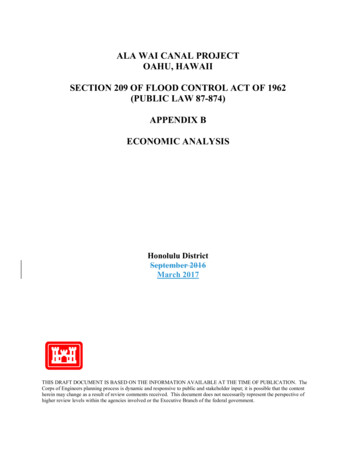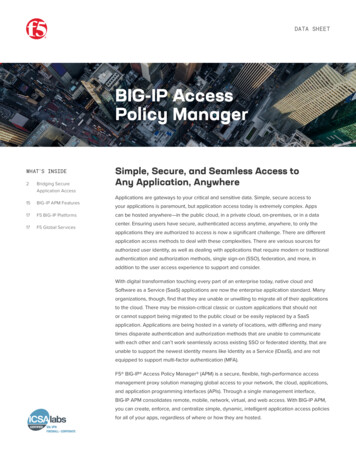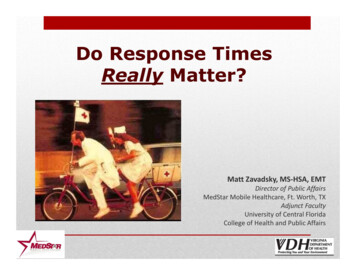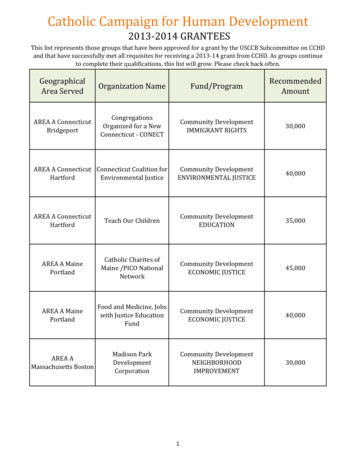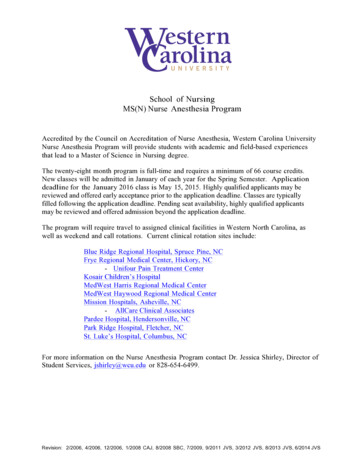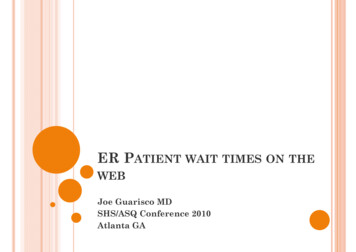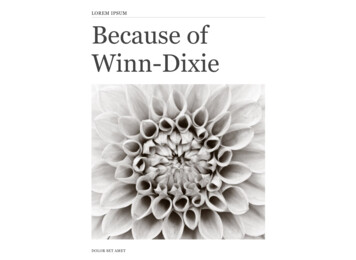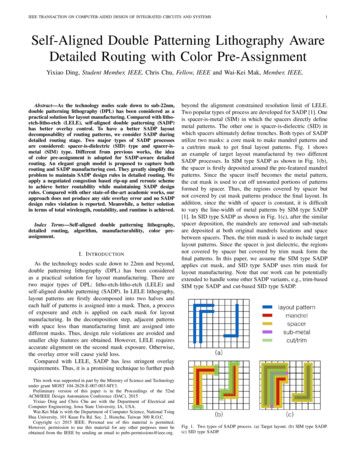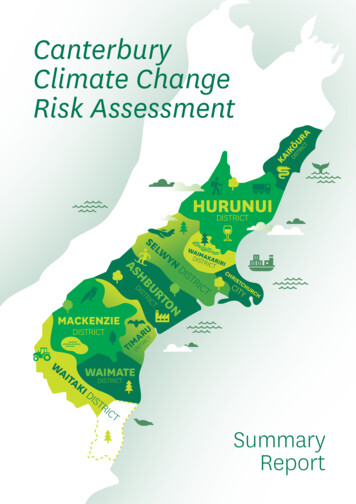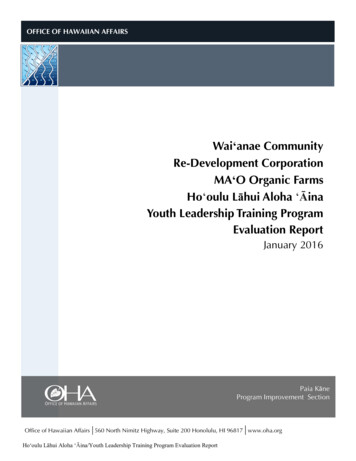
Transcription
OFFICE OF HAWAIIAN AFFAIRSWaiʻanae CommunityRe-Development CorporationMAʻO Organic FarmsHoʻoulu Lāhui Aloha ʻĀinaYouth Leadership Training ProgramEvaluation ReportJanuary 2016Paia KāneProgram Improvement SectionOffice of Hawaiian Affairs 560 North Nimitz Highway, Suite 200 Honolulu, HI 96817 www.oha.orgHo‘oulu Lāhui Aloha ‘Āina/Youth Leadership Training Program Evaluation Report
OFFICE OF HAWAIIAN AFFAIRSEXECUTIVE SUMMARYContentsIntroduction6About MAʻO Farms5Program Goals7Program Budget8Program Staffing8Stakeholders8Purpose of the Evaluation9Scope of the Evaluation9Methodology9Data Collection and Analysis9Program Results10Quantitative Results10Qualitative Results11Additional Qualitative Reporting11Findings12Impact on Native 15The Wai‘anae Community Re-Development Corporation (WCRC)was created in 2000 by a group of residents, traditional practitioners,teachers, and business leaders, with the intent to address needs of theyouth and the community. WCRC’s impact strategy strives to meetfives areas of need: (1) underprivileged youth, (2) sustainable economic development, (3) organic agriculture, (4) health & well-being,and (5) Hawaiian culture. The core objective is to train youth to besocial entrepreneurs and leaders who are culturally-rooted and community-relevant. The end goal is to build a localized youth movement that puts the value of aloha ‘āina into practice.WCRC’s collaborative vision of Ho‘oulu Lāhui Aloha ‘Āina is to regenerate multiple culturally-grounded modern Hawaiian agriculturalventures that restores people and land simultaneously. The center ofthis collaboration is the partnership with the Ali‘i trusts, communitybased, and State-level institutions servicing Hawaiians to shift thecurrent model of export-dependent industrial agriculture to one thatis localized and sustainable. These activities are brought together andimplemented in WCRC’s flagship program, the Mala ‘Ai ‘Opio(translation: youth food garden) Community Food Systems/SecurityInitiative, or MA‘O, which was established in 2001.The mission of MA‘O Farms’, as the social enterprise of the non-profitWCRC, is to restore a strong community food and education systembased on a successful and progressive fourteen-year foundation ofgrowing organic fruits and vegetables while cultivating youth leadersin the community. MA‘O continues its attempts to expand the progress and success of its social enterprises in Lualualei to other areasincluding Waialua and Ewa for participants to work towards postsecondary education and workforce opportunities that reflect the values of caring and nurturing the land. While serving cultural and educational purposes, the Farm as a business produces, processes, markets, and distributes the wide selection of organic fruits and vegetables to various grocery stores, restaurants, farmers’ markets, and direct to consumers.Ho‘oulu Lāhui Aloha ‘Āina/Youth Leadership Training Program Evaluation Report2
OFFICE OF HAWAIIAN AFFAIRSThe program is broken down into two phases. In the first phase, OHA will underwrite the Step Up Internship (SU) for participants who are in their second year of the indigenous education articulation andwill lead teams that are coached by their farm Co-Managers. Students in the program are workings towards their Associate of Arts degree at Leeward Community College (LCC) and those who wish to pursue being food producers are channeled into the Bachelor of Applied Science degree with a concentration in Sustainable Community Food Systems (SCFS) at the University of Hawai‘i West O‘ahu(UHWO). In the second phase, participants provide stewardship to the land with the goal of maintaining the connection to the past and a viable land base. Students’ internships involve the running of thedaily operation of the organic farm. This internship allows participants to take on management roles inexchange for a higher compensation.This initiative primarily addressed the Office of Hawaiian Affairs’ (OHA) strategic priotiries separatedby program phase: phase one addresses Ho‘ona‘auao (education), and phase two addresses ‘Āina (land& water). The program also secondarily addressed Hoʻokahua Waiwai (economic self-sufficiency).Program GoalsThe following performance measures were included in the contract:Performance MeasuresTargetOUTPUTSTotal number of Native Hawaiian Advanced Farm Interns22Total number of Native Hawaiian Advanced Farm Interns enrolled in the sustainable CommunityFood Systems program at UHWO10Total number of Native Hawaiian Advanced Farm Interns enrolled in Associate’s Degree programs5Total number of Native Hawaiian Advanced Farm Interns enrolled in Bachelor’s Degree programs1Total number of Native Hawaiian Advanced Farm Interns who have established IDAs22OUTCOMESTotal number of Native Hawaiian Advanced Farm Interns who receive stipendsTotal amount of stipends provided (in dollars)Total number of Native Hawaiian Advanced Farm Interns who receive tuition supportTotal amount of tuition support provided (in dollars)Total number of Native Hawaiian Advanced Farm Interns who receive IDA match fundsTotal amount of IDA match funds provided (in dollars)22 151,95522 53,85622 44,000Total number of Native Hawaiian Advanced Farm Interns who graduate with an Associate’s Degree3Total number of Native Hawaiian Advanced Farm Interns who graduate with a Bachelor’s Degree0Ho‘oulu Lāhui Aloha ‘Āina/Youth Leadership Training Program Evaluation Report3
OFFICE OF HAWAIIAN AFFAIRSAdditional qualitative reporting included the following reports: the “Fund for success”; Public-private partnership; Collective impact; Leveraging resources; and the Applied learning foryoung adults.Purpose of the EvaluationThe purpose of this evaluation is to determine the program’s collective impact as evidencedby the quantitative and qualitative results as reported in the Grant Assessment reports. Thisevaluation considered the program activities during the time period of June 20, 2014through May 31, 2015.FindingsAs discussed further in the report, the quantitative measures were met and/or exceeded intheir entirety and the additional qualitative reporting was included in the final report- thereby fulfilling the contractual requirements.Programmatic findings were derived from the Grantee’s reporting and from the review ofother contract-related documents. These findings identified gaps in the program’s implementation and how those issues have been and continue to be addressed. The current attrition rate is approximately 50%. The 50% attrition rate was over thecourse of 2.5 years compared to LCC’s 85% attrition rate. This was attributed to students not being prepared at that point to handle the demands of school and the program. Those who leave the program leave with an average of 32 credits. The mitigation strategy used to help resolve this issue is to continue to have counseling supportavailable which would help to track grades, GPA, and other necessary support. Theultimate goal is to reduce the attrition rate to 25%. Increase and ensure continuous enrollment into the SCFS program. The continuousenrollment depends on the job/workforce creation for the farm. With the OHA funds,five full-time and fifty-plus part-time positions were maintained, with two full-timeFarm apprentices and two part-time interns and one part-time extern created. Themitigation strategy includes addressing the academic and financial support challenges by partnering with colleges and other programs and to continue to create a transition to an advanced level of the leadership training.Ho‘oulu Lāhui Aloha ‘Āina/Youth Leadership Training Program Evaluation Report4
OFFICE OF HAWAIIAN AFFAIRSFindings (Continued) Increase productivity and revenue so that operations can expand. During 2015, thefarm had met their goals of generating 600,000 in revenues. The mitigation strategy involves applying consistent procedures and workflow in the farming practice as to creategreater capacity over time. Facilitate continued communication by and between expansion partners. For operations and program efficacy and efficiency, a non-OHA-funded full-time position is dedicated to partnership and network-building. The mitigation strategy is to create feedbackloops in the expansion approach and strategy, convene stakeholders more intentionally,and create collaborative venues for partnership meetings, briefings, and generative discussion.The program demonstrated a positive effect for the community. Program participants benefited from the overall involvement and experience in the program, consumers benefited dueto the ability to purchase produce through the supply chain, and students at LCC and UHWO have an indirect benefit by having the option of studying in the SCFS program withoutserving as an intern.RecommendationsBecause this program was not awarded OHA funding after the contract period, the following programmatic recommendations are applicable to future funding consideration. Invest in edu-preneurial programming for youth. Continue to incorporate and enhancethe mitigation strategies used to address the issues of attrition, enrollment, capacitybuilding, and partnership communication. Invest in deepening and diversifying the college to workforce ʻauwai partnerships.Consider expanding the program internship opportunities to include administrativespecific work aside from fieldwork to include finance, marketing, human resources. Thiswill provide additional administrative and managerial opportunities for interns and potential interns who wish to pursue SCFS and an additional business study. Invest in tracking the social-economic impact return on investment. Consider conducting longitudinal studies examining the continued contribution this program makes towards the community. By highlighting the benefits to participants, consumers, and otherstakeholders, quantifiable metrics to determine a social return on investment could bemade to strengthen the case for continued support of programs using this model.Ho‘oulu Lāhui Aloha ‘Āina/Youth Leadership Training Program Evaluation Report5
OFFICE OF HAWAIIAN AFFAIRSMAʻO Organic FarmsHoʻoulu Lāhui Aloha ʻĀina Youth Leadership Training ProgramProgram EvaluationINTRODUCTIONThe Wai‘anae Community Re-Development Corporation (WCRC) was created in 2000 by agroup of residents, traditional practitioners, teachers, and business leaders, with the intent toaddress needs of the youth and the community. WCRC’s impact strategy strives to meetfives areas of need: (1) underprivileged youth, (2) sustainable economic development, (3)organic agriculture, (4) health & well-being, and (5) Hawaiian culture. The core objective isto train youth to be social entrepreneurs and leaders who are culturally-rooted and community-relevant. The end goal is to build a localized youth movement that puts the value ofaloha ‘āina into practice.WCRC’s collaborative vision of Ho‘oulu Lāhui Aloha ‘Āina is to regenerate multiple culturally-grounded modern Hawaiian agricultural ventures that restores people and land simultaneously. The center of this collaboration is the partnership with the Ali‘i trusts, communitybased, and State-level institutions servicing Hawaiians to shift the current model of exportdependent industrial agriculture to one that is localized and sustainable. These activities arebrought together and implemented in WCRC’s flagship program, the Mala ‘Ai ‘Opio(translation: youth food garden) Community Food Systems/Security Initiative, or MA‘O,which was established in 2001.About MAʻO FarmsMA‘O Farms is the social enterprise arm of the WCRC. Their mission is to restore a strongcommunity food and education system based on a successful and progressive fourteen-yearfoundation of growing organic fruits and vegetables while cultivating youth leaders in thecommunity. MA‘O continues its attempts to expand the progress and success of its socialenterprises in Lualualei to other areas including the Waialua and Ewa areas for participantsto work towards post-secondary education and workforce opportunities that reflect the values of caring and nurturing the land. While serving cultural and educational purposes, theFarm as a business produces, processes, markets, and distributes the wide selection of organic fruits and vegetables to various grocery stores, restaurants, farmers’ markets, and direct to consumers.Ho‘oulu Lāhui Aloha ‘Āina/Youth Leadership Training Program Evaluation Report6
OFFICE OF HAWAIIAN AFFAIRSProgram goalsThe goals of the program are measured in the form of quantitative and qualitative performance and outcome measures- which are stated further ahead in Table 1. Performance andOutcome Measurements Table. Additional qualitative goals were included in the table to beincluded with final reporting from the Grantee, and the logic model includes short-term,mid-term, and long-term outcomes.Table 1. Performance and outcome measurements tablePerformance MeasuresTargetOUTPUTSTotal number of Native Hawaiian Advanced Farm Interns22Total number of Native Hawaiian Advanced Farm Interns enrolled in the sustainable CommunityFood Systems program at UHWO10Total number of Native Hawaiian Advanced Farm Interns enrolled in Associate’s DegreeprogramsTotal number of Native Hawaiian Advanced Farm Interns enrolled in Bachelor’s DegreeprogramsTotal number of Native Hawaiian Advanced Farm Interns who have established IDAs5122OUTCOMESTotal number of Native Hawaiian Advanced Farm Interns who receive stipendsTotal amount of stipends provided (in dollars)Total number of Native Hawaiian Advanced Farm Interns who receive tuition supportTotal amount of tuition support provided (in dollars)Total number of Native Hawaiian Advanced Farm Interns who receive IDA match fundsTotal amount of IDA match funds provided (in dollars)Total number of Native Hawaiian Advanced Farm Interns who graduate with an Associate’sDegreeTotal number of Native Hawaiian Advanced Farm Interns who graduate with a Bachelor’sDegree22 151,95522 53,85622 44,00030Additional qualitative reporting included the following reports: the “Fund for success”; Public-private partnership; Collective impact; Leveraging resources; and the Applied learningfor young adults.Ho‘oulu Lāhui Aloha ‘Āina/Youth Leadership Training Program Evaluation Report7
OFFICE OF HAWAIIAN AFFAIRSProgram budgetAt the May 1, 2014 meeting of the OHA Board of Trustees (BOT), 249,811 from OHA’sfiscal year (FY) 2014 grants budget was awarded to fund the program. Table 2 provides ageneral breakdown of the program activities with which the grant award was used.Table 2. Program budgetCostsIndividual Development Account Match (2:1)StipendsTuition SupportTotal OHA Funds AwardedFY-14 44,000 151,955 53,856 249,811Program staffingUnder the leadership of the Executive Director and the Kauhale Director of Social Enterprise, there are five Co-Managers who manage the daily operations of fieldwork, harvesting,receiving, washing, packing, and delivery. The Co-Managers rotate every three months todevelop their skills in each of these areas. The interns work on Mondays, Wednesdays, andFridays, while attending school on Tuesdays and Thursdays. There is also a staff memberdedicated to assist the interns in planning their school schedules and assisting them in theiracademic progress.StakeholdersDue to multiple dynamic components of the program and its’ operations working at thesame time, there are multiple groups of stakeholders involved in ensuring the success of theprogram, its outcomes, and the preservation of the legacy and continuity of the program.There are several community partners- including OHA- that have formed a network to provide partnerships and to help secure additional supporting resources including but not limited to financial support. During both phases of the program, OHA and KamehamehaSchools’ Ka Pua Initiative provided funding support for both phases while the WK KelloggFoundation provided funding for the first phase only. The partnerships with LCC and UHWO were integrated into the program during the second phase that provided these educational opportunities for students.Supply chain participants make up the points of distribution that takes the final packagedproduce from the farm to the general public. These participants include food retailers suchHo‘oulu Lāhui Aloha ‘Āina/Youth Leadership Training Program Evaluation Report8
OFFICE OF HAWAIIAN AFFAIRSStakeholders (continued)as Whole Foods, Foodland, and the Kaimuki Superette; wholesale retailers, specifically Uptown Catering; restaurants such as Alan Wong’s and Top of Waikīkī, Ed Kenney’s restaurants, Town Restaurant, and Mud Hen Water; and the direct consumers. These supply chainparticipants generate revenue for the goods sold through the chain, but also are reflective ofthe multiplier effect of Native-Hawaiian owned businesses and a workforce matriculationfor culinary professions. Finally, and equally important, with the biggest benefit of this program are the interns working within the farm.Purpose of the evaluationThe purpose of this evaluation is to determine the impact of the program as evidenced byquantitative results showing actual performance results relative to the proposed performance measures and qualitatively by reviewing quarterly narrative responses and by information gained from program staff during the evaluation process. After determining thequantitative and qualitative results, findings were identified and recommendations wereprovided for consideration regarding the future development of this and/or similar programmodels. Because the program was not funded beyond the contract period, the recommendations presented would be applicable in the case of a future funding consideration.Scope of the evaluation. This summative evaluation discusses the program’s achievements and impact on beneficiaries during the time period between June 20, 2014 throughMay 31, 2015.METHODOLOGYThe evaluation in based on all information collected from program documents including thegrant solicitation, program proposal, service contract, quarterly Grant Assessment, the GrantMonitor’s On-Site Monitoring Report, the contract budget, and information gathered duringa site visit held on Friday, December 4, 2015. The program activities and goals were stipulated in the scope of services and in the program proposal.Data collection and analysis. Data was collected from the previously identified documents- all which provided quantitative and qualitative data that was used to measure performance (quantitatively) but to provide a narrative that shows in a non-quantifiable formthe impact that the program has had for program participants and how the program can bea benefit to the community served.Ho‘oulu Lāhui Aloha ‘Āina/Youth Leadership Training Program Evaluation Report9
OFFICE OF HAWAIIAN AFFAIRSData collection and analysis (continued)A quantitative analysis was done by comparing the actual performance measures achieved to the proposed performance measures. A qualitative review of the program’s activities was then done to identify the program structure and how the program was implemented.PROGRAM RESULTSThe following Quantitative Results section discusses the quantitative data reported and the QualitativeResults section discusses the additional activities incorporated in the program.Quantitative resultsProgram results were reported and received by the Grant Monitor. Table 3 below compares the proposed goals as submitted in the contract with the actual results.Table 3. Performance resultsMeasureOUTPUTSTotal number of Native Hawaiian Advanced Farm IntersTotal number of Native Hawaiian Advanced Farm Interns enrolled in the SustainableCommunity Food Systems program at UHWOTotal number of Native Hawaiian Advanced Farm Interns enrolled in Associate’s Degree programsTotal number of Native Hawaiian Advanced Farm Interns enrolled in Bachelor’s Degree programsTotal number of Native Hawaiian Advanced Farm Interns who have established IDAsOUTCOMESTotal number of Native Hawaiian Advanced Farm Interns who receive stipendsTotal amount of stipends provided (in dollars)Total number of Native Hawaiian Advanced Farm Interns who receive tuition supportTotal amount of tuition support provided (in dollars)Total number of Native Hawaiian Advanced Farm Interns who receive IDA match fundsTotal amount of IDA match funds provided (in dollars)Total number of Native Hawaiian Advanced Farm Interns who graduate with an Associate’sDegreeTotal number of Native Hawaiian Advanced Farm Interns who graduate with a Bachelor’s DegreeHo‘oulu Lāhui Aloha ‘Āina/Youth Leadership Training Program Evaluation 0%)16/1(160%)32/22(146%)32/22(146%) 151,955/ 151,955(100%)22/22(100%) 53,856/ 53,856(100%)32/22(146%) 44,000/ 44,000(100%)16/3(533%)0/0(--%)10
OFFICE OF HAWAIIAN AFFAIRSQuantitative results (continued)Upon submitting the quantitative results, the Grantee also provided the following statementsregarding the results: The goal of students enrolled in the Associate’s Degree program was set too low. The Bachelor’s Degree program was formally recognized by UHWO, and therefore students who were/will be enrolled in the SCFS courses were unofficially enrolled in theformal degree-seeking program. The majority of interns received stipends. The exceptions were due to program participation with partnering organizations. Tuition support came from various sources including OHA. No Bachelor’s Degrees were attained during the contract period. However, 88% ofgraduates have enrolled in Bachelor’s Degree-seeking programs.Quantitative results not included in the performance measures include the following: Enterprise & Academic GPA average of 3.1. Enterprise revenue generation of 600,000. 200% visitor increase since 2008.Qualitative resultsQualitative results illustrate the impact of the program on participants and how the programwas developed and/or implemented that couldn’t be measured quantitatively. As a contractual requirement and therefore subject to inclusion in this evaluation, additional qualitativereporting was included as a reporting requirement in the Performance and Outcome Measurements Table that accompanied the narrative responses in the quarterly Grant Assessment report.Additional qualitative reportingThe following additional qualitative reporting requirements were included in the contractrequirements: “Fund for success” report; Public-private partnership report; Collective impactreport; Leveraging resources report, and; Applied learning for young adults report thatwould be included with the final report. There were also indirect outputs or outcomes to beHo‘oulu Lāhui Aloha ‘Āina/Youth Leadership Training Program Evaluation Report11
OFFICE OF HAWAIIAN AFFAIRSAdditional qualitative reporting (continued)addressed relating to the following areas: Understanding History and Perpetuating Hawaiian Culture Employment Core Services for Native Hawaiians Native Hawaiians Achieving Pae ʻĀina Sustainability Obesity and Physical Health Improvements in Native Hawaiians Exceed Education StandardsThe responses detailing and showing completion of these reporting requirements are detailed in Appendix B. Additional Qualitative Reporting Responses.FINDINGSIn reviewing the program documents and the responses submitted by the Grantee in theGrant Assessment reports, programmatic findings were identified during the course of theevaluation process either by self-reporting from the Grantee and from reviewing other information presented in the reporting. The findings ahead identified gaps in the administering ofthe program and how those issues have been and continue to be addressed.The first challenge was the overall program attrition rate. The current attrition rate is approximately 50% compared to LCC’s attrition rate of 85%. The attrition rate is attributed to students not being prepared at that point to handle the demands of school and the program.Those who leave the program leave with an average of 32 credits. The mitigation strategyused to help resolve this issue is to continue to have counseling support available whichwould help to track grades, GPA, and other necessary support. The ultimate goal is to reduce the attrition rate to 25%.The second challenge is to increase enrollment into the SCFS program and to ensure continuous enrollment into the program. The continuous enrollment depends on the job/workforce creation for the farm. With the OHA funds, five full-time and fifty-plus part-timepositions were maintained, with two full-time Farm apprentices and two part-time internsand one part-time extern created. The mitigation strategy includes addressing the academicand financial support challenges by partnering with colleges and other programs and tocontinue to create a transition to an advanced level of the leadership training.The third challenge is to increase productivity and to increase revenue so that operationscan expand. During 2015, the farm had met their goals of generating approximatelyHo‘oulu Lāhui Aloha ‘Āina/Youth Leadership Training Program Evaluation Report12
OFFICE OF HAWAIIAN AFFAIRS 600,000 in revenues. The mitigation strategy involves applying consistent procedures andworkflow in the farming practice as to create greater capacity over time.The fourth challenge is to facilitate continued communication by and between partners inexpansion. For operations and program efficacy and efficiency, a non-OHA-funded fulltime position is dedicated to partnership and network-building. The mitigation strategy is tocreate feedback loops in the expansion approach and strategy, convene stakeholders moreintentionally, and create collaborative venues for partnership meetings, briefings, and generative discussion.Impact on Native Hawaiian beneficiariesThe program demonstrated a positive effect for the community in several ways. From acommunity perspective, while every stakeholder group benefits from the success of this program, the stakeholder group with the greatest benefit was the participants because theylearned valuable skills that are rooted in culture that promote their academic and practicaldevelopment. The second group with the greatest benefit was the consumers of the producegenerated by the Farm due to the natural tangible goods they receive through the supplychain.Due to the Farms’ involvement in constructing and implementing this program, has alsohelped in the creating of the SCFS program. The investment in the formalization of the SCFSprogram was done by promoting the demand from advanced MA‘O students and how theprogram has implications for non-MA‘O students. The SCFS program also creates an opportunity for future students interested in pursuing these areas without direct involvement inthis internship.During a post-contract site visit conducted on December 4, 2015, input was received fromprogram staff- which was discussed previously- and program participants. One participant,Sheila, discussed some things she had learned from her education and experience in thisprogram, specifically the following three points: The trajectory of her family had shifted from poverty towards prosperity because of education and entrepreneurism skills and experiences;She and her siblings have encountered challenges as Native Hawaiian women in postcolonial structures and frameworks of higher education;Agriculture and farming was inherent to her heritage as an asset and its application toher chosen field of study of architecture and her hope to integrate the two fields.Ho‘oulu Lāhui Aloha ‘Āina/Youth Leadership Training Program Evaluation Report13
OFFICE OF HAWAIIAN AFFAIRSRECOMMENDATIONSBecause this program was not awarded OHA funding after the contract period, the following programmatic recommendations are applicable to future funding consideration. Invest in edu-preneurial programming for youth. Continue to incorporate and enhancethe mitigation strategies used to address the issues of attrition, enrollment, capacitybuilding, and partnership communication.Invest in deepening and diversifying the college to workforce ʻauwai partnerships.Consider expanding the program internship opportunities to include administrativespecific work aside from fieldwork to include finance, marketing, human resources. Thiswill provide additional administrative and managerial opportunities for interns and potential interns who wish to pursue SCFS and an additional business study.Invest in tracking the social-economic impact return on investment. Consider conducting longitudinal studies examining the continued contribution this program makes towards the community. By highlighting the benefits to participants, consumers, and otherstakeholders, quantifiable metrics to determine a social return on investment could bemade to strengthen the case for continued support of programs using this model.Ho‘oulu Lāhui Aloha ‘Āina/Youth Leadership Training Program Evaluation Report14
OFFICE OF HAWAIIAN AFFAIRSAPPENDICESHo‘oulu Lāhui Aloha ‘Āina/Youth Leadership Training Program Evaluation Report15
OFFICE OF HAWAIIAN AFFAIRSHo‘oulu Lāhui Aloha ‘Āina/Youth Leadership Training Program Evaluation Report16
OFFICE OF HAWAIIAN AFFAIRSHo‘oulu Lāhui Aloha ‘Āina/Youth Leadership Training Program Evaluation Report17
Ho'oulu Lāhui Aloha 'Āina/Youth Leadership Training Program Evaluation Report OFFICE OF HAWAIIAN AFFAIRS Office of Hawaiian Affairs 560 North Nimitz Highway, Suite 200 Honolulu, HI 96817 www.oha.org Paia Kāne Program Improvement Section Waiʻanae Community Re-Development Corporation MAʻO Organic Farms Hoʻoulu Lāhui Aloha ʻĀina
